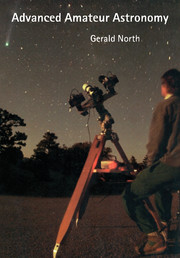Book contents
- Frontmatter
- Contents
- Preface to the second edition
- Preface to the first edition
- Acknowledgements
- 1 Telescope optics
- 2 Atmosphere, seeing, magnification and eyepieces
- 3 Telescope hardware and adjustments
- 4 Astrophotography with the camera
- 5 Astrophotography through the telescope
- 6 Electronic imaging
- 7 The Moon
- 8 The terrestrial planets
- 9 The gas-giant planets
- 10 Asteroids, comets, meteors and aurorae
- 11 The Sun
- 12 Variable stars and novae
- 13 Methods of photometry
- 14 Double stars, star clusters, nebulae, galaxies and supernovae
- 15 Spectroscopy
- 16 Radio astronomy
- 17 Further information
- Appendix: Useful formulae
- Index
14 - Double stars, star clusters, nebulae, galaxies and supernovae
Published online by Cambridge University Press: 04 August 2010
- Frontmatter
- Contents
- Preface to the second edition
- Preface to the first edition
- Acknowledgements
- 1 Telescope optics
- 2 Atmosphere, seeing, magnification and eyepieces
- 3 Telescope hardware and adjustments
- 4 Astrophotography with the camera
- 5 Astrophotography through the telescope
- 6 Electronic imaging
- 7 The Moon
- 8 The terrestrial planets
- 9 The gas-giant planets
- 10 Asteroids, comets, meteors and aurorae
- 11 The Sun
- 12 Variable stars and novae
- 13 Methods of photometry
- 14 Double stars, star clusters, nebulae, galaxies and supernovae
- 15 Spectroscopy
- 16 Radio astronomy
- 17 Further information
- Appendix: Useful formulae
- Index
Summary
Double star measures provided the astrophysicist with essential raw data. It is from these data that binary star orbits and stellar masses can be determined. Combining these with the results of other types of observation, the astrophysicist can build up a portrait of the component stars and gain insights into the structure, behaviour and evolution of stars in general. Sadly, though, the number of amateur astronomers carrying out this work is vanishingly small. In part this is due to it being perceived as far less exciting than, say, hunting novae or planetary observing. Many are also put off by the exacting demands made upon the observer and the telescope.
By contrast, observing star clusters, nebulae and galaxies is a highly popular pastime among backyard observers. The results may not advance astronomy but this is more than made up for by the knowledge that one is observing the largest structures in the Universe, situated in the depths of space and time.
Are the vast stellar systems, even the external galaxies, totally devoid of life and wheeling in cold loneliness in the void? Perhaps. On the other hand, when we view a galaxy as a hazy smudge, are we really looking down on to myriads of worlds teeming with almost unimaginable varieties of life? Maybe some alien ‘backyard observer’ is, perchance, pointing his/her/its telescope in our direction and wondering the same thing!
Supernovae, collosal stellar explosions where a star can shine as brightly as a galaxy, are particularly exciting.
- Type
- Chapter
- Information
- Advanced Amateur Astronomy , pp. 314 - 333Publisher: Cambridge University PressPrint publication year: 1997



